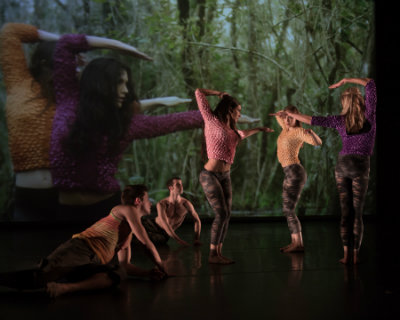Parsons Dance 2013

"Dawn to Dusk" choreographed by David Parsons. Photo by Eric Bandiero.
BOTTOM LINE: New and old works add up to an impressive, at times curious, program by the veteran dance company.
Parsons Dance has returned to The Joyce Theater in an attempt to prove that what modern dance needs are more alligators. The 2013 program includes a new work from David Parsons entitled “Dawn to Dusk,” which is a celebration of Southern Florida. This is coupled with another, more subtle, new work from former company member Katarzyna Skarpetowska called “Black Flowers.” The somber Chopin-accompanied work is an exploration of Skarpetowska’s Polish roots.
The program begins with Mozart in the exuberant 2005 piece from Parsons, “Wolfgang.” It is a celebratory play on dominant/subordinate. Featuring a base costume design from David Murin and dynamic lighting from Howell Binkley, it is reserved on the acrobatics but is packed with humor and story. It invigorates with a play of freedom and desire inside a joyful tension.
Skarpetowska’s premiere piece “Black Flowers” is a more struggled interplay of suppression. She highlights binaries as clearly as the black and white costume design by Reid Bartelme. Christopher Chambers lighting is sharp and dramatic. In exploring her Polish heritage she is exploring isolation and repression. With this gloomy undertone she has Christina Ilisije echo this repression in a physicalized form of mental torture in one of the more captivating solos of the evening. She celebrates the invididual, yet removes individuality in a haunting way.
Now back to the alligators. “Dawn to Dusk” is the centerpiece of the program that comes out of a commission by Wolf Trap (America’s National Park for the Performing Arts). The company spent ten days immersed in Southern Florida’s diverse ecology. A backdrop shows projections of birds, swamps and dancers submerged in the Everglades. Photos by Clyde Butcher and film by Blue Land Media engulf the stage as live dancers mimic or interact with the scene behind them. It begins with a dancer crossing downstage left away from the high-def gator looming behind her.
It feels as though Parsons crew had more fun with exploring the wild than creating nuanced art. There are not a lot of layers in linked dancers forming an alligator, or flapping arms like the elegant crane on the screen. The moments when the choreography is inspired by the landscape rather than repeating are most successful. It can be awkward to have live dancers in sync with their digital selves. The eye is drawn to the vibrantly filmed dancers and away from the physical beings on stage, questioning the reasoning of this interplay. A quote about the need to “get wet” from a native begins the piece. There's a sense that Parsons wishes to show just how wet they got on their excursion. To this end it functions better as a photography show than a live performance. Andrew Bird’s compositions accompany the photography wonderfully, still.
“Dawn to Dusk” ends escaping from nature and entering the nightlife of contemporary Miami dance clubs with vivid music by Cuban band Tiempo Libre. While sexy and engaging, as the sole human component of the region, it rings false as a true exploration of Southern Florida culture.
Also on the program is the revolutionary 1982 Parsons piece, “Caught.” If you’ve never reveled in Parson’s illusionary spectacle it still marvels. While Robert Fripp’s music sounds like a theme from an Atari game, the ingenius play of light, darkness and space is timeless. Parsons’s aesthetic interaction of dance and light are a staple of the company, and this is the seminal example. Danced by a rotating trio of soloists, it was Eric Bourne performing the acrobatic magic on opening night. The progression from spotlights to strobe lights creates a filmic trick of the eye that holds the audience captive.
The final portion of the program is Parsons’s “In the End.” This 2005 creation is a celebration of Dave Matthews. It’s an easy-going bright dance full of large sweeping choreography that moves vast space rapidly. Mia McSwain’s costumes warm the stage in summer. Like Matthews, the individual qualities of the work are awash with a pleasant mood that ultimately charms.
(Parsons Dance will be at The Joyce Theater, 175 8th Avenue between 18th and 19th Streets, through January 27, 2013. Performances are Tuesdays and Wednesdays at 8PM; Sundays at 1PM and 5PM; and a special family-friendly matinee on Saturday, Janurary 26th at 2PM. Tickets are $10-$59 and are available at joyce.org or by calling 212.242.0800.)

